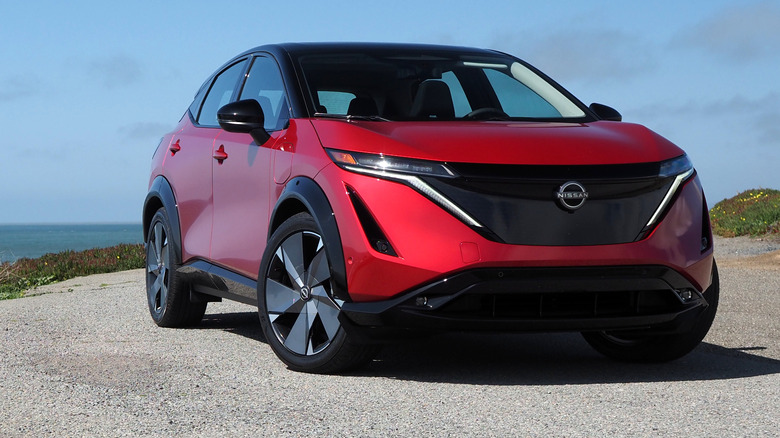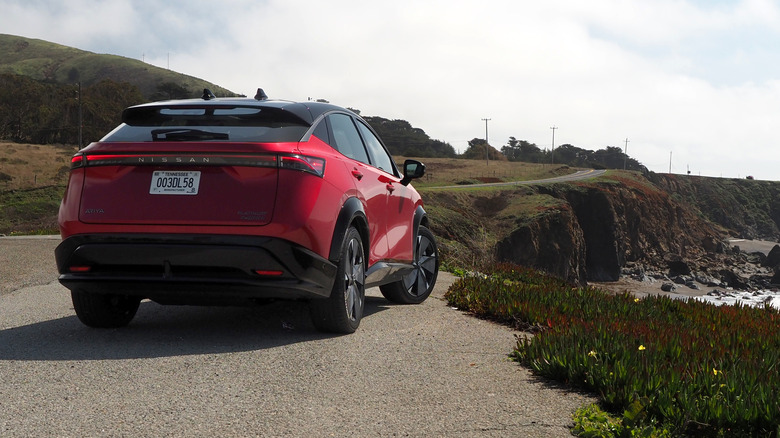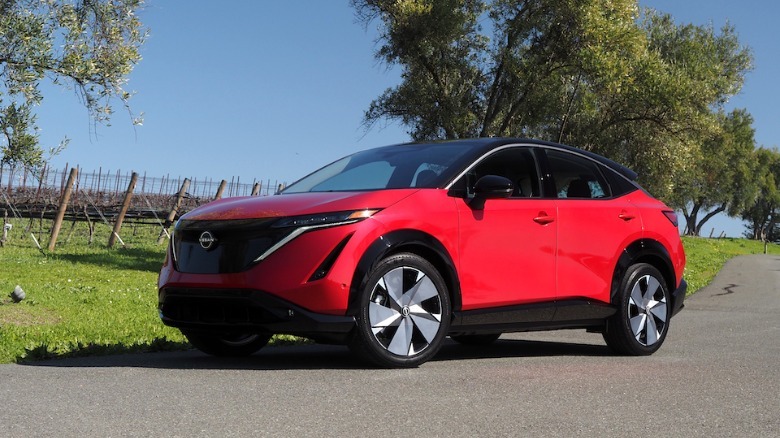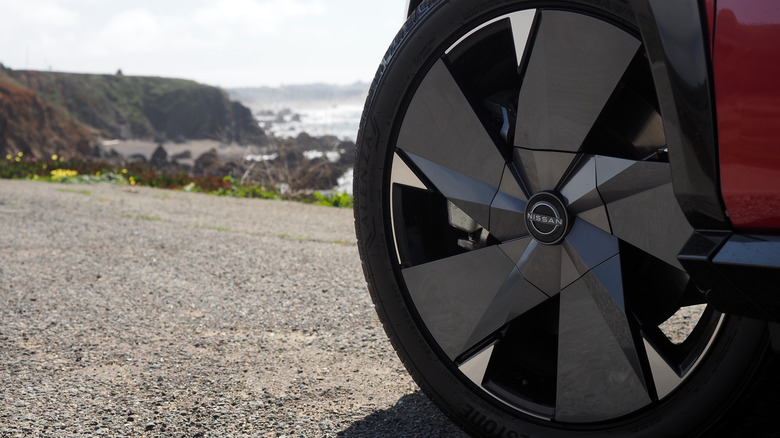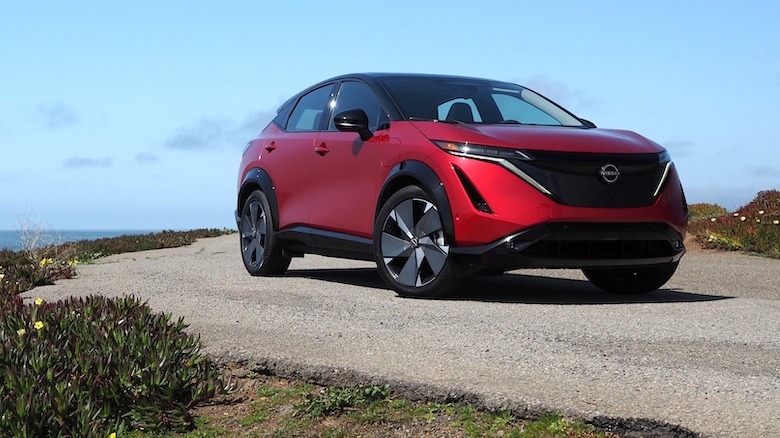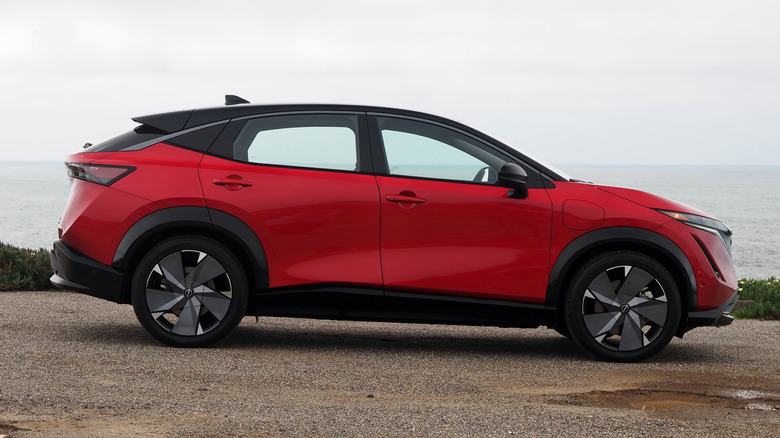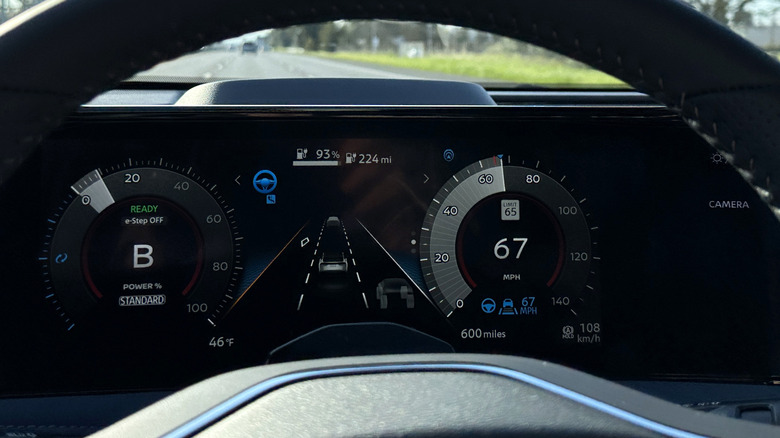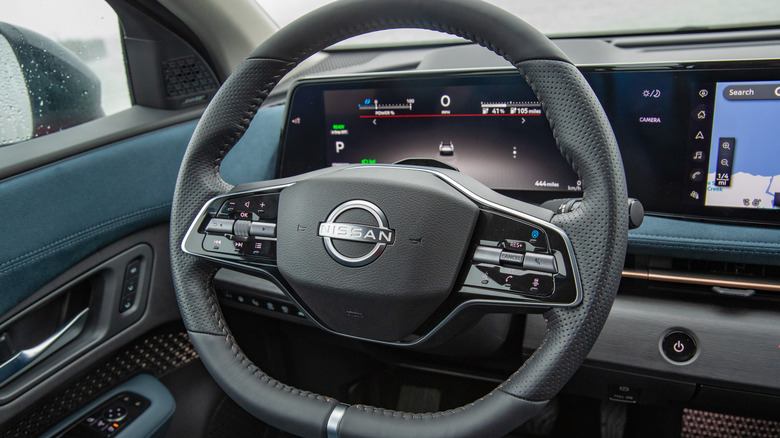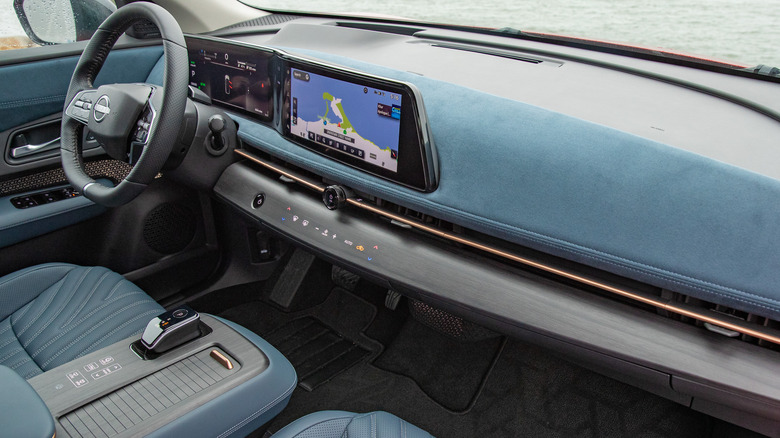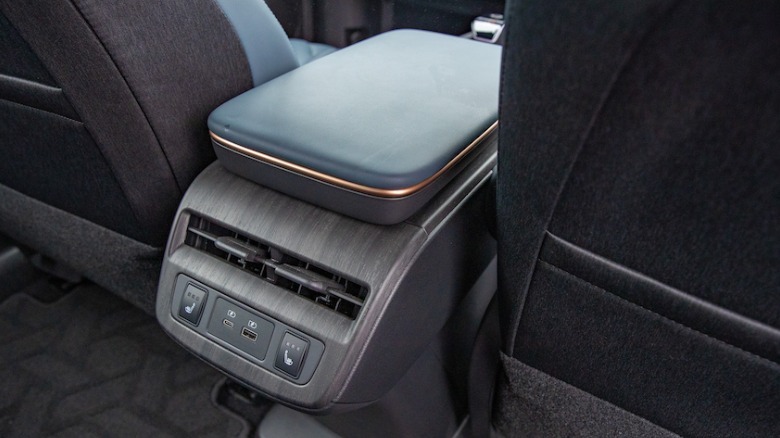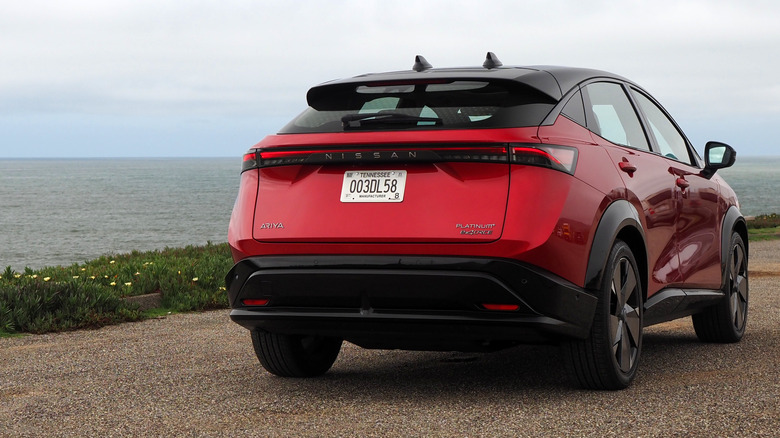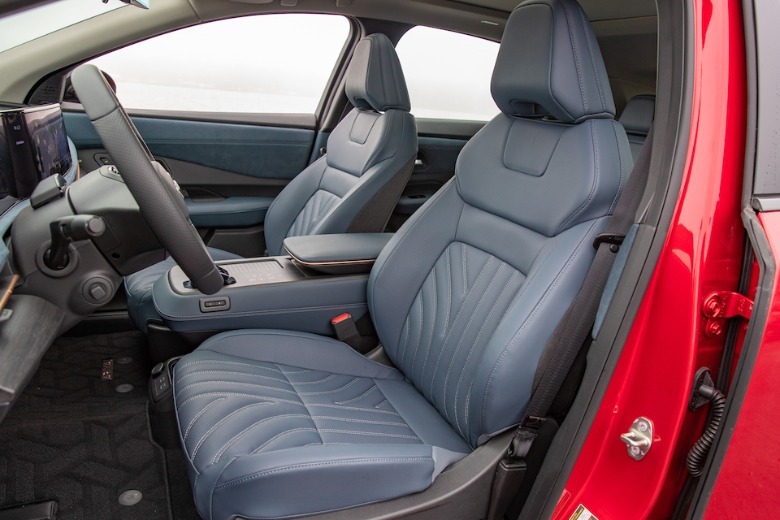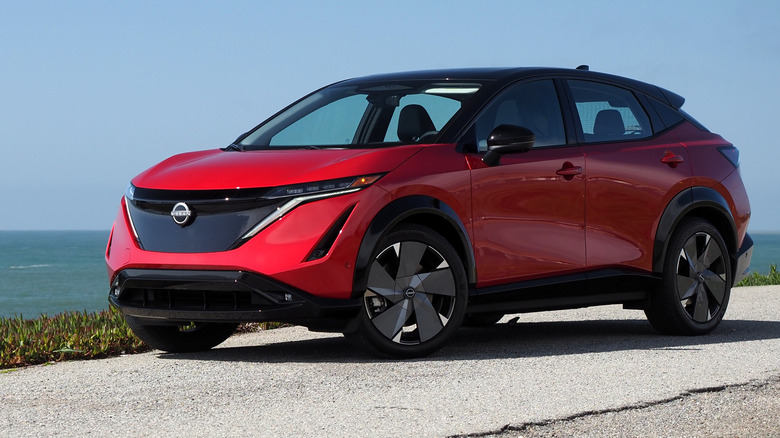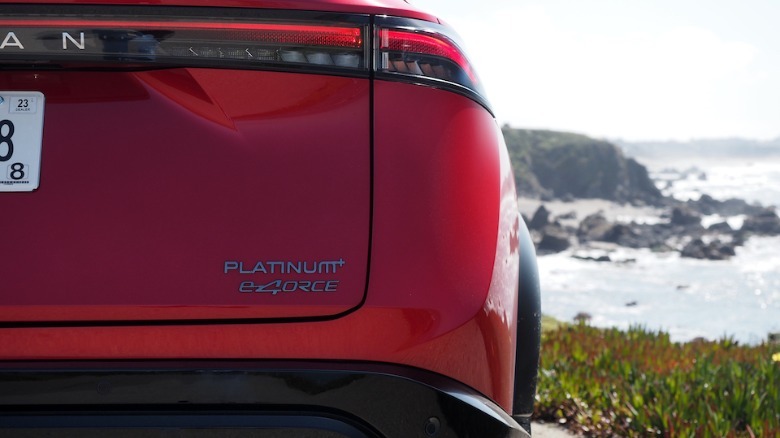2023 Nissan Ariya E-4ORCE First Drive: AWD Gives This Stylish EV The Pep It Deserves
The Tesla Model Y is no longer the only option when it comes to all-electric crossovers, and after years of playing catch-up, EVs like the 2023 Nissan Ariya e-4ORCE are arriving to widen the field. Nissan's Leaf may have helped grow the electric car segment, but it's the Ariya — more stylish, more capable, and generally more confident — that the Japanese automaker is counting on to popularize it. We just had to wait a while for the right car, and the right configuration, to come along.
Nissan opted for a staggered launch for the Ariya. The more affordable, front-wheel drive Ariya landed in the U.S. first, with deliveries beginning in the fall of 2022. Starting $4k more, from $47,190 (plus destination), the Ariya e-4ORCE promised a few good reasons to be patient.
All-wheel drive is, unsurprisingly, popular among drivers living in cold-weather states, where increased traction in snow and ice is not just a nicety but a necessity. However, there are also clear performance advantages. The Ariya FWD does 0-60 mph in a quoted 7.2 seconds, but the e-4ORCE version trims that to a quoted 4.8 seconds.
Stylish and aerodynamic
Though less striking when not in the Sunrise Copper paint that Nissan offered to pre-release reservation holders, the Ariya remains a handsome SUV. Distinctive enough to stand out from the automaker's gas-powered models, yes, but not so outlandishly odd that traditionalists will blanch.
Nissan's narrow, squinting headlamps with their hockey-stick daytime running lights look premium, while the black lower grille, side fenders, and wheel cladding either stand out as a bold contrast with lighter paints or blend in more with darker hues. Nobody is going to confuse the Ariya for a true off-road machine — with 6.7 to 6.9 inches of ground clearance, trim depending, the all-wheel drive model is actually lower than its front-wheel drive sibling — but you could say the same for most consumer SUVs.
19-inch wheels are standard, with the same 235/55R19 all-season tires as the front-wheel drive Ariya. They have a special aerodynamic design that resembles the macerating blades from some kind of industrial blender. Nissan also offers the Platinum+ e-4ORCE with optional 20-inch alloys, too; they won't cost you in dollars, but they'll trim 10 miles from the EV's range.
Enthusiasm to match the design
With two electric motors rather than one, it's no surprise that the Ariya e-4ORCE is considerably more powerful than the front-wheel drive version. That tops out at 238 horsepower and 221 lb-ft of torque; in contrast, the base-spec Engage e-4ORCE musters 335 horsepower and 413 lb-ft, while the more expensive all-wheel drive models pack 389 hp and 442 lb-ft.
Nissan pairs the uptick in power in its max-strength Ariya AWD models with a bigger set of vented disc brakes than in the FWD car: 14.3 inches, rather than 13.8 inches. However, much of the time you'll be relying on regenerative braking to slow the car. Nissan's e-Step regenerative braking system is aggressive even if it's not capable of bringing the Ariya to a complete halt.
Where the front-wheel drive car was perfectly adequate, the e-4ORCE adds the enthusiasm that the Ariya deserves. Straight-line acceleration is plenty fast — though Plaid mode fans won't find quite the same degree of organ rearrangement here — and Nissan's combination of front-to-rear power distribution and brake-based torque vectoring keeps it planted in the corners, too. There's a little body roll if pushed especially hard, but no sense that you're going to lose traction in the process.
A weird soundtrack for a very quiet EV
Sport mode adds weight to the steering and makes the acceleration curve more aggressive. Unfortunately, it also throws in an artificial sound, akin to an increasingly angry industrial sewing machine, and there's no way to turn it off. Here's hoping Nissan relents and pushes out an over-the-air (OTA) fix to at least make that optional because otherwise, the Ariya is one of the quietest cars out there thanks to acoustic and laminated glass. Spending all that effort, only to layer in an unlovable sound effect, seems counter-intuitive.
Whether in Sport, Normal, Eco, or Snow mode, the Ariya is composed. Nissan is particularly proud of how it uses both front and rear regenerative braking to avoid nose-diving when you slow the EV.
Nissan's hands-free driver assistance, ProPilot Assist 2.0, is standard on the flagship Platinum+ e-4ORCE trim ($60,190); lesser Ariya make do with the standard, hands-on adaptive cruise and lane-keeping. That's a shame, because there's a lot to like about ProPilot Assist 2.0, even if it can't quite do — today, at least — everything its hands-off rivals can.
Ariya, take the wheel
As long as you're on a stretch of the divided highway that Nissan has HD mapping data for — currently around 200,000 miles worth — the system will allow you to take your hands off the wheel and rely on an attention-tracking camera to ensure you're still poised to retake control if necessary. If traffic ahead slows, and there's room in the faster lane to your left, the Ariya will suggest a maneuver. Or, you can manually trigger a lane change by tapping the indicator yourself.
For those lane changes to actually happen, however, your hands need to be back on the wheel; a light touch is fine, as Nissan uses both capacitive and torque sensors to track contact. Like all these systems — GM's Super Cruise and Ford's BlueCruise included — it's a fairly cautious driver. That means maneuvers may be a little slower than the traffic situation might demand, and at times I missed my opportunity to overtake because ProPilot Assist 2.0 was unduly reticent.
It also won't prompt you to move into an HOA lane — Nissan's argument is that there's no way of knowing if you're eligible, though sadly the Ariya can't take into account HOA lanes which are only limited access at certain times of day — and at times the lane-keeping can be twitchy. That was particularly the case when driving into bright sunlight, with Nissan confirming that the cameras ProPilot Assist 2.0 uses for lane centering can be dazzled. Even so, it's a solid system that definitely left me feeling more relaxed on an extended highway cruise.
Reasonable range but slower charging
As for range, the cheapest trim gets a smaller battery — 66 kWh, of which 63 kWh is usable — which is EPA rated for 205 miles of driving. The Ariya Engage+ e-4ORCE (from $51,190), Evolve+ e-4ORCE, and Platinum+ e-4ORCE have a 91 kWh battery with 87 kWh usable; that's rated for 272 miles on the Engage+ and Evolve+, and 267 miles on the Platinum+.
130 kW DC fast charging support remains, a 10-80% top-up taking 35-40 minutes, battery size depending. Or, figure on 10.5-14 hours for a 0-100% charge if you're plugging into a Level 2 charger at home. Honestly, the Ariya's DC fast charging rate lags many of its rivals, but given the lackluster performance at a lot of public stations that might not be the most frustrating part of the overall experience. All Ariya buyers get 12 months of EVgo charger access.
I wasn't doing a specific range test, but over the course of 103 miles of mixed highway, urban, and back road driving in an Ariya Platinum+ e-4ORCE the battery dropped from 99% to 59%. That suggests 258 miles of total range, not far from Nissan's best-case estimate for the car. The Ariya quoted 3.3 miles/kWh.
A high level of standard equipment
Generally, there's a higher level of equipment to be had in this e-4ORCE version of the EV. Every trim gets steering wheel heating, while the Platinum+ e-4ORCE has power wheel adjustment. A power driver's seat is standard across the board, too, as are heated front seats; the Platinum+ adds cooled front seats too. All e-4ORCE trims have heated rear seats, that recline and split 60/40.
A 12.3-inch infotainment system with wireless Apple CarPlay and wired Android Auto is standard, plus four USB ports, and a six-speaker audio system. The Platinum+ trim swaps the latter for a 10-speaker Bose audio upgrade. Only Evolve+ and Platinum+ cars get a wireless charging pad, but a 12.3-inch driver display, 10-inch head-up display, dual-zone climate control, and parking sensors front and rear are standard across the board.
So, too, is a fairly comprehensive active safety suite. Automatic emergency braking, lane departure warnings with intervention, blind spot warnings and intervention, rear cross-traffic alert and automatic braking, and ProPILOT Assist with Navi-link are present on every trim.
A cabin benchmark for Nissan
While the equipment levels may vary, one thing holds true: the Ariya has the best cabin of any recent Nissan. The combination of design, materials, and technology make for a space both practical and charming. Do we really need a motorized central console between the front seats, or a power-deploying cubby that slides out from under the dashboard? Probably not, but they're fun along with being functional.
Capacitive buttons glow through the dash, with a haptic buzz as you tap them. Nissan's revamped infotainment software still isn't quite as slick as, say, CarPlay or Android Auto, but it's a big improvement over the automaker's other cars. Japanese-inspired ambient lighting manages to avoid feeling gimmicky.
Nissan's interior as a whole is spacious, tapping the packaging advantages made possible by electrification. The Ariya is about the length of a Rogue on the outside, but total interior volume is just 16 cu-ft smaller than that of a Murano. The EV's swooping roofline limits cargo space in comparison to its gasoline siblings, mind: 22.8 cu-ft with the rear seats up, and 59.7 cu-ft with them dropped down.
As for towing, where the Ariya FWD lacks an official rating, the e-4ORCE can manage 1,500 pounds. Don't go lifting the hood to find more space, though. Nissan intentionally skipped the front trunk, or frunk, in favor of maximizing cabin space.
2023 Nissan Ariya e-4ORCE Verdict
The absence of secure front storage isn't the only frustrating omission. Nissan doesn't offer bidirectional charging or V2L (vehicle-to-load) functionality, where the Ariya could use its battery to power a home or campsite. There are 12V outlets, but none of the useful 110V outlets that many rival EVs include.
Nissan's general argument is that the transition to electrification is still early, and the bulk of Ariya buyers aren't necessarily looking for those more advanced features. Certainly, initial demand there has been promising, with 62% of Ariya reservations apparently from customers new to Nissan. The company's aftercare — including an 8-year/100,000-mile battery warranty, 3 years/36,000 miles of scheduled maintenance coverage, and 3 years of roadside assistance including a tow if you run out of charge — seems tailored to assuage the anxieties of EV newbies, too.
I can't really argue too much with that strategy, and I can't be too dismissive of the Ariya either. Certainly, you could make a strong case that Nissan should've launched this e-4ORCE version first, rather than the more pedestrian front-wheel drive model, and you could accuse it of being priced a little richly compared to its competition. Nissan's counter is that Ariya equipment levels are stronger, eschewing paid options in favor of four distinct trims. If what's on the spec sheet lines up with what you want from an electric crossover, then, the 2023 Ariya e-4ORCE is not only a solid contender in the mainstream EV category but quite possibly the most compelling model in Nissan's current line-up, period.
